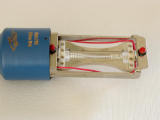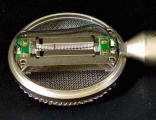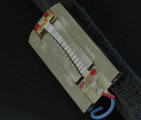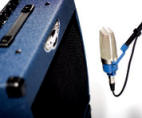After my discussion of ribbon mic mods, Michael at OktavaMod sent me some pictures of sagging ribbons, something you might encounter while working on your mic.
The most common symptoms of a loose ribbon are low output and decreased low-frequency response. With your mic open, it’s easy to see if the ribbon sags. But with sealed, un-modded mics, the protective mesh hides the ribbon. So If you suspect your ribbon needs tightening, but don’t want to disassemble the mic to check, Michael recommends a quick and dirty test: Connect the microphone to a mixer, and listen through headphones while rocking the mic back and forth. If the ribbon is slack, you’ll hear a clanging sound when the ribbon hits the magnet.
Ribbon repair
Repair is straightforward, though requires a delicate touch. Read the discussion, again thanks to Michael, on Gearslutz (and a similar TapeOp thread):
One or both of the ribbon clamps must be loosened and removed. Then the ribbon pried gently away from the lower clamp surface. Occasionally the ribbon is fused to the clamp surface and cannot be moved without tearing. In this case the last resort is to hope the other end of the ribbon can be freed from the clamp and pulled taught.
You might also need the previously-noted page about replacing the ribbon element in a ribbon microphone.
(And the easiest way, especially if you’re all thumbs: Have OktavaMod repair the mic for you.)
Tags: microphones, pictures




 I spend as much time as any guitar player tweaking knobs to find great tones. Here are some links that have helped me in the quest:
I spend as much time as any guitar player tweaking knobs to find great tones. Here are some links that have helped me in the quest: Inspired by “
Inspired by “ Yesterday, I described a
Yesterday, I described a  In what FutureMusic dubs
In what FutureMusic dubs  Watch for “the wall”: Marathon runners hit a wall somewhere around the 20-mile mark. Mixing engineers experience something similar: After a point, mixes don’t get better, they just get different. Learning to recognize when you’ve reached this point is crucial to improving as a mix engineer. Unlike runners, however, engineers who hit the mixing wall should stop what they’re doing! Take a break. Or better yet, consider that the mix might actually be finished!
Watch for “the wall”: Marathon runners hit a wall somewhere around the 20-mile mark. Mixing engineers experience something similar: After a point, mixes don’t get better, they just get different. Learning to recognize when you’ve reached this point is crucial to improving as a mix engineer. Unlike runners, however, engineers who hit the mixing wall should stop what they’re doing! Take a break. Or better yet, consider that the mix might actually be finished!